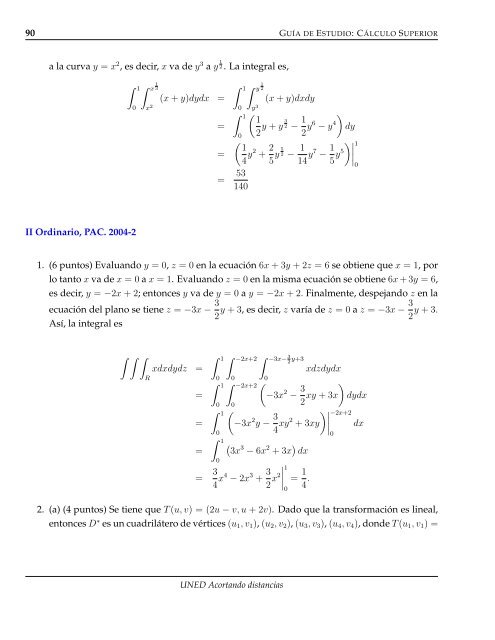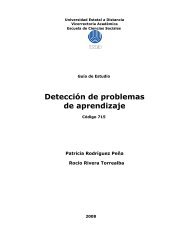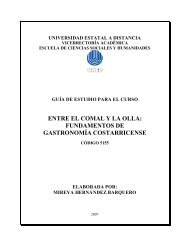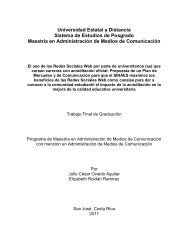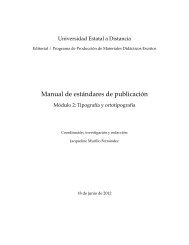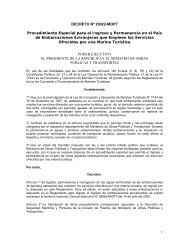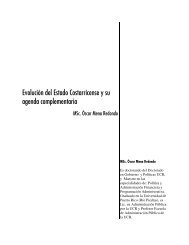GE3011 Cálculo Superior - Repositorio de la Universidad Estatal a ...
GE3011 Cálculo Superior - Repositorio de la Universidad Estatal a ...
GE3011 Cálculo Superior - Repositorio de la Universidad Estatal a ...
Create successful ePaper yourself
Turn your PDF publications into a flip-book with our unique Google optimized e-Paper software.
90 GUÍA DE ESTUDIO: CÁLCULO SUPERIOR<br />
a <strong>la</strong> curva y = x 2 , es <strong>de</strong>cir, x va <strong>de</strong> y 3 a y 1<br />
2 . La integral es,<br />
II Ordinario, PAC. 2004-2<br />
1<br />
1<br />
x 3<br />
0<br />
x 2<br />
(x + y)dydx =<br />
=<br />
=<br />
1<br />
1<br />
y 2<br />
(x + y)dxdy<br />
0 y3 1 <br />
1 3<br />
y + y 2 −<br />
0 2 1<br />
2 y6 − y 4<br />
<br />
1<br />
4 y2 + 2 5<br />
y 2 −<br />
5 1<br />
14 y7 − 1<br />
5 y5<br />
= 53<br />
140<br />
<br />
dy<br />
1. (6 puntos) Evaluando y = 0, z = 0 en <strong>la</strong> ecuación 6x + 3y + 2z = 6 se obtiene que x = 1, por<br />
lo tanto x va <strong>de</strong> x = 0 a x = 1. Evaluando z = 0 en <strong>la</strong> misma ecuación se obtiene 6x + 3y = 6,<br />
es <strong>de</strong>cir, y = −2x + 2; entonces y va <strong>de</strong> y = 0 a y = −2x + 2. Finalmente, <strong>de</strong>spejando z en <strong>la</strong><br />
ecuación <strong>de</strong>l p<strong>la</strong>no se tiene z = −3x − 3<br />
3<br />
y + 3, es <strong>de</strong>cir, z varía <strong>de</strong> z = 0 a z = −3x − y + 3.<br />
2 2<br />
Así, <strong>la</strong> integral es<br />
<br />
R<br />
xdxdydz =<br />
=<br />
=<br />
=<br />
1 −2x+2<br />
0 0<br />
1 −2x+2<br />
0<br />
1<br />
0<br />
1<br />
0<br />
−3x− 3<br />
2 y+3<br />
1 <br />
xdzdydx<br />
0<br />
<br />
−3x<br />
0<br />
2 − 3<br />
<br />
xy + 3x dydx<br />
2<br />
<br />
−3x 2 y − 3<br />
4 xy2 −2x+2 <br />
+ 3xy dx<br />
0<br />
3 2<br />
3x − 6x + 3x dx<br />
= 3<br />
4 x4 − 2x 3 + 3<br />
2 x2<br />
<br />
<br />
<br />
<br />
1<br />
0<br />
= 1<br />
4 .<br />
2. (a) (4 puntos) Se tiene que T (u, v) = (2u − v, u + 2v). Dado que <strong>la</strong> transformación es lineal,<br />
entonces D ∗ es un cuadrilátero <strong>de</strong> vértices (u1, v1), (u2, v2), (u3, v3), (u4, v4), don<strong>de</strong> T (u1, v1) =<br />
UNED Acortando distancias<br />
0


